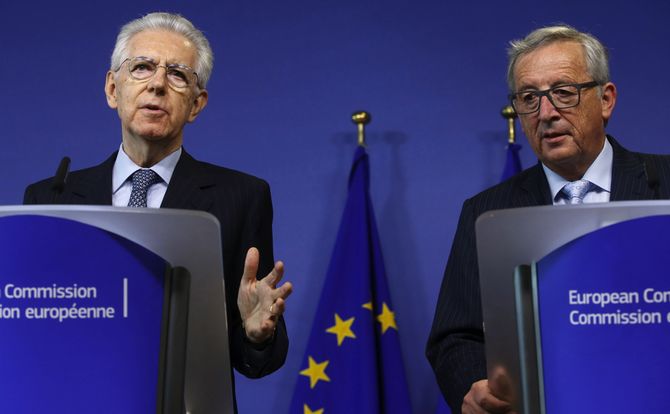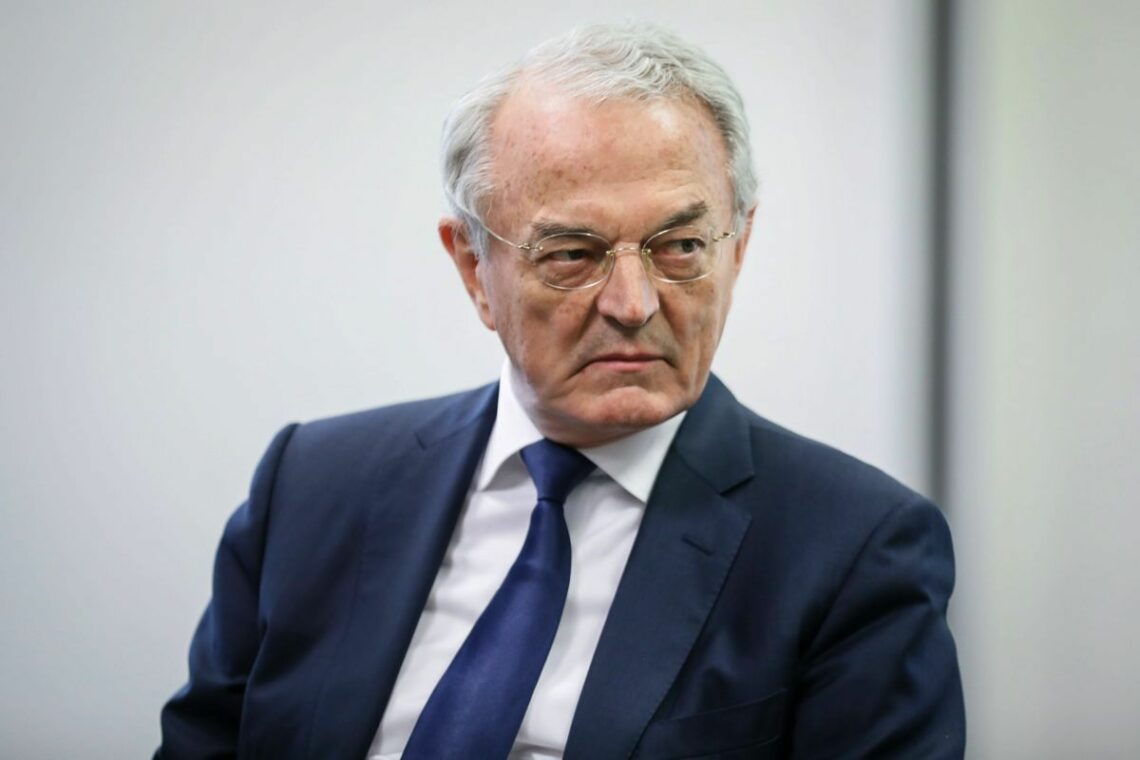New narratives emerging on EU finances
The European Union’s inflexible budget process – constrained by seven-year Multiannual Financial Frameworks (MFFs) – has left the bloc almost incapable of handling major crises. The resort to ad hoc solutions over the past decade has only made the situation worse.

In a nutshell
- Lack of own revenue and seven-year financial plans have hamstrung EU finances
- This “budget corset” often forces cheating as bills for multiyear programs go unpaid
- Instead of curbing spending, the EU is now searching for more revenue sources
- An “EU tax” is not yet on the agenda, but a separate eurozone budget might be
Every seven years, the European Union adopts a new Multiannual Financial Framework (MFF) that establishes how much it can spend over a seven-year period, both in total and in designated policy areas. Even though most European citizens are unaware of it, the shift to a new MFF is always an important moment, because it gives EU leaders an opportunity to rethink their political priorities.
Inter-institutional negotiations laying out the basis for the next MFF (covering the period 2021-2027) have recently begun. Next May, the European Commission will present a first proposal to the European Parliament and the Council of the EU – the two branches of the EU budget authority – in the hope that a final agreement can be reached before spring 2019, when the next European parliamentary elections are held.
The upcoming negotiations promise to be tenser than ever. Europe is facing a daunting array of challenges: Brexit, the migrant crisis, the threat of terrorism and cyberattacks, climate change, not to mention aging populations and persistently high unemployment. With a budget that amounts to no more than 1 percent of the European gross domestic product (equivalent to 1 trillion euros in the 2014-2020 budgetary period), the EU in its present configuration is simply not equipped to deal with long-term crises of this size and scope.
Seven-year straitjacket
Lack of resources alone, however, does not explain the EU’s growing inability to deal with major crises. The strict rules and procedures governing annual EU budgets put them into what Jean Arthuis, the chairman of the European Parliament’s budget committee, described as the “straitjacket of a seven-year MFF.” Consequently, there is little scope for flexibility when serious crises flare up, such as the refugee influx of 2015 or the Greek debt crisis.
Under pressure, the EU budget authorities tend to improvise case-by-case solutions.
Forced to react under pressure, the budget authorities tend to improvise pragmatic, case-by-case solutions outside the MMF’s “corset.” This is usually done by creating so-called flexible instruments or ad hoc funds (for example, the European Fund for Strategic Investment), which are supposed to deal with issues by their own rules and under a separate system of accountability.
Over the years, these “peripheral bodies” – to use Mr. Arthuis’ phrase – have proliferated around the EU budget. The result has been to dilute one of the budget’s fundamental principles – unity – while increasing the complexity of EU financing system and eluding parliamentary control.
Unpaid bills
Equilibrium – another basic premise of EU budgets – is challenged by the very rules of the system. Since the EU budget must always be balanced, it cannot run an annual deficit or be financed by debt. However, given the short time horizon of the annual budget and the long-term obligations involved in many EU-financed programs, the Commission has often been unable to pay beneficiaries on time. Unpaid bills may disrupt the balance of EU budgets, delay or hamper the realization of key programs, and ultimately harm the credibility of European institutions. Between 2013 and 2015, payments arrears reached an unprecedented peak of over 20 billion euros. In 2017, after years of effort, this “abnormal backlog” was phased out, at least temporarily.
Programs in the development and aid sector (European Civil Protection and Humanitarian Aid Operations or EuropeAid, for example) have been particularly affected by the unpaid bills problem in recent years. But even the two keystones of EU budgets – the Common Agricultural Policy (CAP) and Cohesion Policy, which together account for 75 percent of EU expenditures –have long suffered from the mismatch between EU commitments and actual funding.
Bureaucratic hurdles
Some of EU budgeting’s other core values – efficiency and fairness – are also being undermined by needlessly complicated application procedures and excessive reporting and monitoring requirements. Initiated with good intentions of curbing corruption and rent-seeking, this red tape ends up driving away the beneficiaries these programs were supposed to help, like farmers and fishermen.
Despite recent reforms aiming at simplifying the CAP, the decades-long structural crisis of European farmers has only deepened, to the point that many consider the CAP to be responsible. Likewise, in domains as diverse as research, education, innovation, energy, transport, networks, health or food safety, vital projects are being stalled by bureaucratic hurdles, while others, much less useful or important, sail through. The key selection criterion has become skill at dealing with the mountain of required paperwork.
The whole EU budget system is unintelligible not just to ordinary citizens, but also to experts and insiders.
Far from being an effective investment instrument, even less a tool for crisis management, the EU budget has become a source of mistrust and dissatisfaction. It has mutated into a huge and inert redistribution machine, obsessed with control and supervision, bureaucratic beyond belief. It is expensive as well: the EU spends more than 9.5 billion euros a year on its central administration, or 6 percent of its annual budget. The whole system is unintelligible not just to ordinary citizens, but also to experts and insiders. The situation has become so farcical, and the inability of EU institutions to correct it so obvious, that its main effect has been to reinforce the arguments of euroskeptics, Mr. Arthuis has observed.
Opaque financing
The “political powerlessness” so regretted by the head of the European Parliament’s budget committee is partly due to its virtual exclusion from the process of raising revenue for the central budget. Parliament has a say concerning the level and structure of expenditure (for both the MMF and annual budgets), but only in conjunction with the Council and under strictly regulated negotiating procedures – brokered by the European Commission.
As for budgetary sources of revenue, Parliament is merely “consulted,” while the Council retains the exclusive decision-making power. This asymmetry, embedded in the EU budgetary system, is not without risks for democracy, since representative institutions are completely disconnected from the most important aspects of Union finances.
Since its founding treaties essentially withhold the power of taxation, the EU must rely on three revenue streams, or “own resources,” as they are called in the bureaucratic parlance, to fund thousands of programs and projects all over Europe. By far the most important is based on gross national income (GNI), which is used to compute the contributions of individual member states to the EU budget. The second resource is VAT-based, with governments paying in a share of their adjusted VAT receipts to the common budget. The third, relatively minor resource is made up of customs duties collected by member states on behalf of the EU. Other, comparatively small and irregular sources of income include interest on late payments and fines paid by companies that breach competition law.
Budgetary procedure has long been a zero-sum game in which each member state seeks to optimize the difference between what it pays and what it gets.
“Overcomplicated,” “opaque” and “riddled with complex correction mechanisms” were some of the terms used to describe the revenue side of the EU budget in a recent European Commission reflection paper on the future of EU finances. A famous example is the “UK correction” or “rebate” (first introduced in 1985, before becoming permanent), as well as the “rebates on the UK rebate” and other financial compensation for countries that claim to have contributed more than their fair share.
Zero-sum game
While Brexit will free the next MFF from the baffling problem of rebates and correction mechanisms, the well-known “juste retour dilemma” will not disappear when the UK leaves the Union. It is deeply rooted in the EU budgetary procedure, which has long been a zero-sum game in which each member state seeks to optimize the difference between what it pays and what it gets. This mindset, the very opposite of the EU’s early spirit, will continue to poison budget negotiations, which more than ever are divided into two antagonistic blocs at budgetary sessions of the EU Council – net contributors on one side, and net recipients on the other.
Five scenarios
As the current MFF cycle nears its end, all concerned actors agree on the necessity to modernize this “relic of the past”, as the 2004 Sapir Report called the EU budget. As to how this should be done, however, opinions in Brussels greatly diverge.
For the Commission, the answer depends on what kind of post-Brexit Union will be strived for, and how ambitious the 27 remaining member states will be in working toward this goal. In the “White Paper on the Future of Europe” issued in March 2017, European Commission President Jean-Claude Juncker’s team outlined the impact on EU finances of five different scenarios for 2025. In the first, the EU-27 simply “carries on” without the UK, coping as best it can with the loss of this important partner and contributor. In the second, member states decide to “do less together,” refocusing on the single market. The third possibility is a multispeed Europe, “allowing some to do more than others in specific areas.” Fourth would be a fundamentally restructured Union “doing less more efficiently.”

All four of these options entail a scaling back of EU ambitions and, consequently, a shrinking of the bloc’s common budget. Just the opposite is assumed in the fifth and final scenario, in which the 27 member states decide to “do much more together” – including paying much more to Brussels than they have so far.
More Europe rather than less is clearly the Commission’s preferred option. President Juncker has repeatedly argued for significantly increased revenue for the EU budget, which he claims now costs the individual European taxpayer just “a cup of coffee a day.” He insists Europe could do much more if citizens would only be willing to make an effort. What he has in mind is a “results-focused” budget, equivalent to at least 1.2 percent of European GDP, instead of the current 1 percent.
New own resources
Where would the extra money come from? A High Level Group on Own Resources (HLGOR), set up jointly by Parliament, Council and Commission in 2014 and chaired by former Italian Prime Minister Mario Monti, made concrete recommendations in a report released in January 2017.
In addition to reforming the current VAT-based resource, the Monti group suggested that a range of new own resources be introduced in the next MFF, either gradually or under certain preconditions. Many of the new levies are related to “green” initiatives. The most likely candidates for implementation would be an EU corporate income tax, a financial transaction tax and other financial activities tax, a CO2 levy, an electricity tax and a levy on motor fuels.
Under the existing institutional setup, as Mr. Monti’s panel acknowledged, an EU tax is inconceivable.
Other potential sources include indirect taxes on imported goods from high-emission countries; revenues from border control, the digital single market, environmental protection and energy efficiency; and even currency issuance by European central banks (“seigniorage”). A charge for individuals entering the EU’s external borders is also possible once the EU Travel and Authorization System (ETIAS) becomes operational in 2020.
EU tax
The possibility of “introducing anything resembling an EU tax” was also raised in the HLGOR report, but in very cautious and general terms. Giving the European Parliament “real tax-raising power” would have the advantage of establishing “a more direct link between citizens and the EU budget,” introducing “more democratic accountability in EU financing.” It would also loosen the MMF straitjacket, providing flexibility to deal with unforeseen emergencies.
But, for this, treaties would need to be changed. Under the existing institutional setup, as HLGOR acknowledged, an “EU tax” is inconceivable. “Whether … such a step is desirable is a very fundamental political question,” the report by Mr. Monti’s high-level group concludes, without elaborating.
Two budgets
Slowly but surely, however, a new narrative is emerging in debates on EU finances. One of the more radical reform options that has been proposed involves constructing an entirely new budget, either inside or outside the existing EU one. The idea would be to shrug off the MMF’s constraints by giving the euro area a specific “fiscal capacity” to manage crises, especially those involving issues related to the Monetary Union, such as the need for automatic stabilizers.
As pointed out by former Eurogroup President Jeroen Dijsselbloem, the prevailing EU fiscal rules, governed by the Stability and Growth Pact, have become so complex and prey to political bargaining that they are no longer functional. This could become dangerous if another sovereign debt crisis occurs. Most EU finance ministers thus favor a separate eurozone budget of several hundred billion euros, financed from special taxes (on digital commerce, for example) or new country contributions.
The creation of a new eurozone budget would complicate rather than simplify EU finances.
Under this scenario, it is not clear how the existing EU-27 budget would be reformed. It might be increased to incorporate the eurozone budget (with a separate line on both the revenue and expenditure side), or it might be scaled back and in time eclipsed by the new budget, which would begin to function independently and according to very different rules and principles. These latter might include the possibility of direct taxation.
It is also unclear whether the creation of a eurozone budget would imply transferring the Union’s power to dispose of existing national tax receipts. The alternative – which goes against the HLGOR’s recommendations – would be a general increase in the tax burden imposed on euro area citizens.
On all these matters, nothing has been decided yet. Negotiations will almost certainly be lengthy, especially because a new eurozone budget would complicate rather than simplify EU finances.
French President Emmanuel Macron has emerged as the most ambitious and impatient advocate of a “New European Union.” He proposes to create ad hoc a 19-member eurozone government, with its own permanent finance minister, Treasury and collection administration. There would also be a new eurozone parliament, endowed with genuine fiscal powers.
The European Commission is expected to make its first proposals on this matter by the end of 2018. Whether it resembles the “grand European plan” imagined by President Macron, or whether it is even viable, will depend on many factors. One is political backing from Berlin, which is far from assured.
Even with such big ideas, the future of European integration seems as uncertain as ever. What is looming for sure is what Jean Arthuis calls a “two-tiered Europe,” with all that that implies.








